Deep in the heart of Spain, Toledo, nicknamed the ‘City of Three Cultures’, showcases the Christian, Muslim and Jewish influences that reign over the city’s stunning architecture. This medley of cultures has left the city with some of the finest examples of Gothic, Renaissance and Mudéjar artistry and a combination of Gothic and Muslim styles that makes Toledo unique.
Just 43 miles (83 km) south of Madrid in the Castilla-La Mancha region of Spain, the Tagus River wraps around the city, providing a natural line of protection against invasion. Many structures around the city were created as defensive strongholds, and over many centuries of conquests, the original buildings and walls were reshaped and transformed to serve new functions.
Toledo dates back to Roman times, however, much of the ancient structures were destroyed or built upon. One remnant of this ancient city, the Alcántara Bridge, the tallest Roman bridge in the world, remains, providing the first access to this incredible city. For centuries Toledo’s fame throughout Europe came from the production of weapons, especially swords known for their resilience in battle. Legend has it that the Tagus River waters aided the blades’ strength.
In 1986, UNESCO recognized Toledo as a World Heritage Site because of the city’s rich historical and cultural past. Besides the impressive architectural features, the city also houses extensive art collections, including works from El Greco, who made Toledo his home and final resting place. Thousands of years of captivating history and incredible architecture draw 3 million visitors annually to see this city’s wonders first-hand. Here are some of the best things to do in Toledo.
Contents
- Toledo, Spain
- Top Tours
- 20 Things To Do in Toledo
- 1- Marvel At The Astounding El Alcázar
- 2- Learn About Military History At The Toledo Army Museum
- 3- Go Back Thousands Of Years At The Oldest Monument In Toledo
- 4- Admire the Stunning Gothic Architecture At Catedral Primada
- 5- Explore Castilian Gothic Architecture
- 6- Cross The River Tagus On The Puente De Alcántara
- 7- Explore The Castillo Of San Servando
- 8- Start Your Day At The Plaza Zocodover
- 9- Admire The Incredible Paintings Of A Brilliant Artist At The El Greco Museum
- 10- Enjoy The Best View Of Toledo At The Mirador del Valle
- 11- Get A Glimpse Of El Greco’s First Paintings At Convento de Santo Domingo El Antiguo
- 12- Walk Through The Magnificent Puerta De Bisagra Nueva
- 13- Contempate The Construction Of The Puente de San Martín
- 14- Gaze At Fantastic Views Of The City At The Puerta Del Sol
- 15- See El Greco’s Painting At Iglesia de Santo Tomé
- 16- Visit Toledo’s Art Collection At Museo de Santa Cruz
- 17- Attend A Performance At Puy du Fou España Theme Park
- 18- Learn About Jewish History At Sinagoga De Santa María La Blanca
- 19- Explore Italian Art and El Greco’s Works At Hospital De Tavera
- 20- Go Back 700 Years In History At Convento De Santa Clara La Real
Toledo, Spain
Top Tours
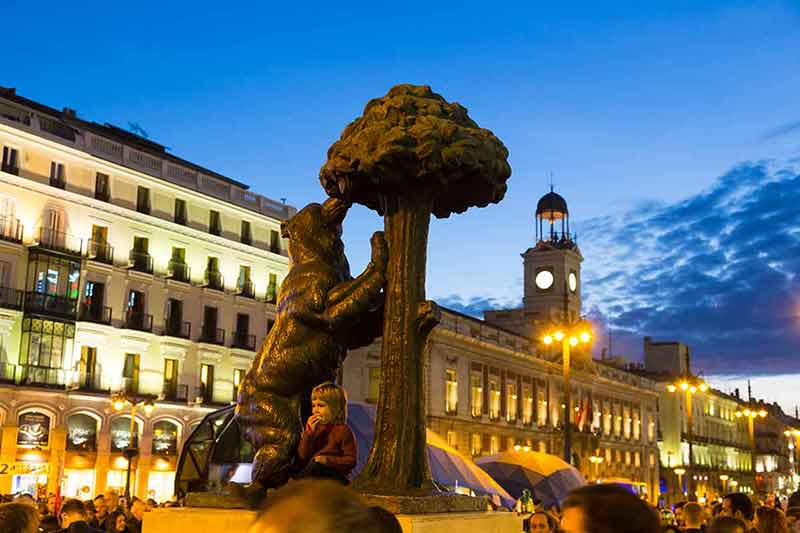
- From Madrid: Day Tour to Toledo – this city can be explored in one day.
- Toledo: Hop-On Hop-Off Bus Tour – save money and explore at your leisure. It includes a walking tour and entry to Alcazar.
- Toledo: Hot Air Balloon Ride – soar above the city and enjoy a Spanish breakfast.
20 Things To Do in Toledo
1- Marvel At The Astounding El Alcázar
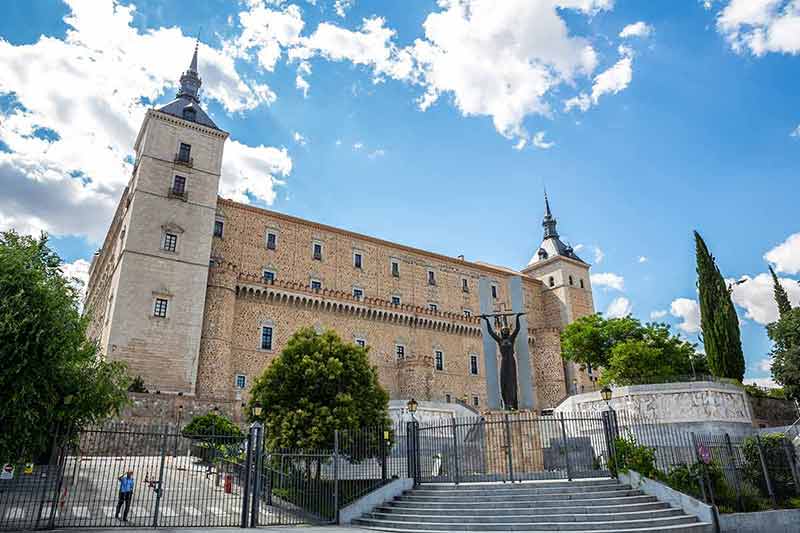
The crown jewel of Toledo perched high above the city, the El Alcázar fortress takes you on a journey through the city’s diverse history, from ancient times up to the modern day.
The many rulers of Toledo moulded this magnificent structure over centuries into its present form.
The Romans laid the El Alcázar’s first foundation as a strategic defensive stronghold.
Later King Veovigildo, during the Visigothic era from 573-586 AD, used the fortress as his royal residence, establishing his capital in Toledo.
After the Muslims conquered the city, under the orders of Abd al-Rahman III, El Alcázar became transformed into a residence for the cadi (judges).
In 1085, Alfonso VI reconquered Toledo and built a new Alcázar on top of the existing one.
When Charles V returned to Spain, the fortress was modified again in 1535 to what we see today, a square palace with Renaissance-style facades measuring 197 ft (60 meters) on each side, with square towers rising 194 ft (59 meters).
In the interior, the central courtyard features Corinthian capitals on the columns below semicircular arches on two floors.
El Alcázar currently functions as the headquarters for the Military Government of Toledo.
The palace also contains the Toledo Army Museum and on the upper floor, the Library of Castilla-la-Mancha.
El Alcázar is at C. de la Union, s/n, 45001 Toledo.
Recommended tours:
- Toledo: Hop-On Hop-Off Bus Tour, Walking Tour & Alcazar
- Toledo: Exclusive Private Tour with Licensed Guide
2- Learn About Military History At The Toledo Army Museum
Housed inside the Alcázar, Toledo’s Army Museum takes you back to the 19th century with its large collection of swords, knives, firearms, artillery, medals and other ethnographic objects.
Dating back to Roman times, the city is renowned for producing high-quality swords and other weapons using unique methods and the strongest steel in the world.
It is said that the waters of the Tagus River contained special powers providing strength while forging the blades.
Toledo was Europe’s primary weapons source during the 15th, 16th, and 17th centuries.
Inside the museum, founded in 1803, the large collection features over 35,000 items, bringing you back to the days of conquest in Spain.
The Toledo Army Museum is at C.de la Paz, s/n, 45001 Toledo, Spain.
3- Go Back Thousands Of Years At The Oldest Monument In Toledo
Originally built as a mosque in 999 AD, the Mezquita Cristo de la Luz or “Mosque of the Christ of Light”, features intricate designs from both Hispano-Muslim and Mudéjar influences.
This structure, comprised of two distinct sections, goes back centuries into the history of the Iberian peninsula.
Some regard this church as the birthplace of the Mudéjar style.
After the reconquest of Toledo in the 12th century, King Alfonso VI constructed an apse in the Romanesque style, transforming it into a Christian church.
Because of this, the original structure was preserved, similar to many other mosques in the city.
Legend has it that a beam of light guided the king to a small figure of Christ that had been hidden for centuries.
After capturing the city in 1085, his horse fell in front of the chapel.
The story goes on to say a candle had been burning the entire time during the Muslim rule, and as he explored the mosque, he found the crucifix of Jesus.
The name of the church comes from this legend.
The inscription on the wall states that the first mass was held here after the King conquered Toledo.
Mezquita Cristo de la Luz is located at C.Cristo de la Luz, 22, 45002 Toledo.
Recommended tour: Toledo: Guided Monument Walking Tour with Wristband Pass
4- Admire the Stunning Gothic Architecture At Catedral Primada
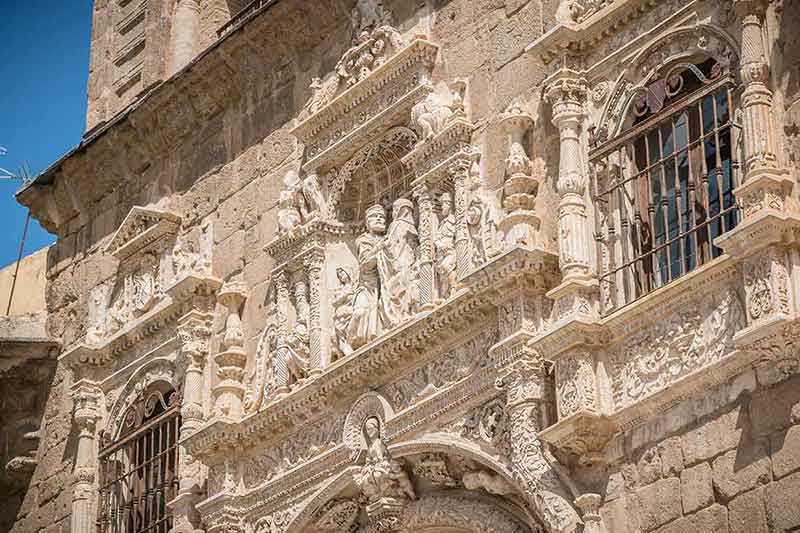
The Cathedral of Toledo, or the Catedral Primada, represents one the finest examples of medieval Gothic architecture in Spain.
In 1227, Archbishop Don Rodrigo Jiménez ordered the construction of this magnificent structure, situated over the ruins of a Mosque from the sixth century.
Modelled after a cathedral in Borges, the French influences are apparent in the high limestone columns supported by flying buttresses on the exterior, providing additional support to support high ceilings, ribbed vaults and brilliant stained glass windows.
One of Spain’s top 10 visited cathedrals, it also houses some impressive works by Goya, Veláquez, and El Greco, Toledo’s most famous painter.
Take time to marvel at the ceiling created by Luca Giordano or stare into the El Transparente, a distinct feature built into the dome resembling a cave.
The cathedral of Toledo is located at Calle Cardenal Cisneros, 1, 45002 Toledo.
Recommended tour: Toledo: Cathedral Tour with a Local Guide
5- Explore Castilian Gothic Architecture
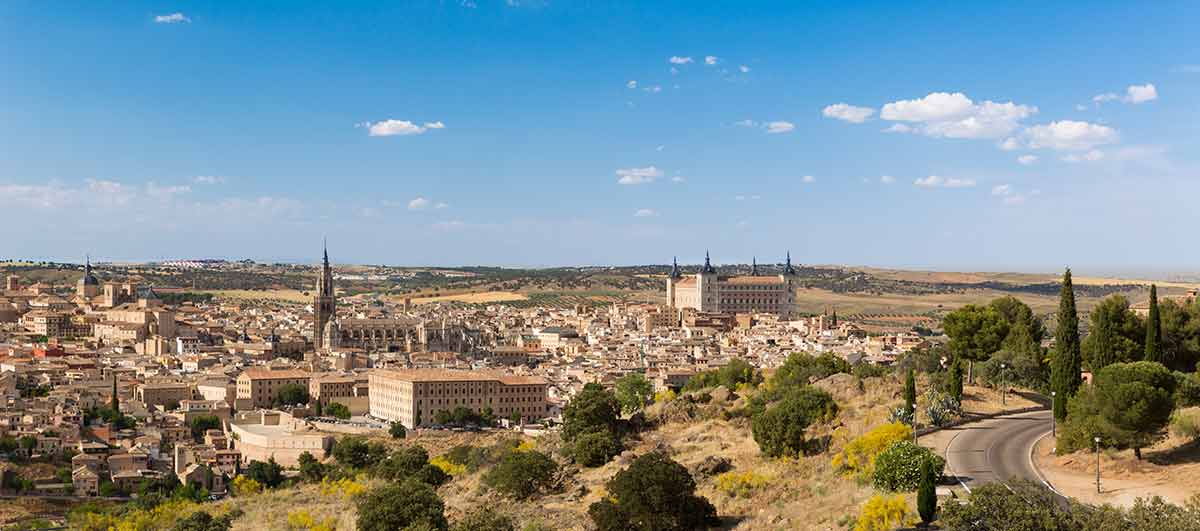
In the heart of the Jewish quarter of Toledo, you will find the 15th-century Franciscan monastery and church founded by the Catholic monarchs Isabel and Fernando in 1476 to demonstrate their deep faith.
Originally these rulers intended to be buried here but later ended up in Granada, their grand conquest.
This two-level cloister monastery features two styles of architecture, gothic on the lower level and Mudéjar on the upper level, surrounding a lush garden in the centre.
The corridors are adorned with beautiful arches, ribbed vaulted ceilings, statues, and gargoyles, painstakingly sculpted to perfection.
The adjoining church displays a large coat of arms supported by the eagles of St. John, representing the Catholic monarchs.
On the outside, look for hanging chains on the northeastern side of the building that once belonged to the Christian prisoners freed from the Muslim Granada.
The Monasterio de San Juan de Los Reyes is at C.de los Reyes Católicos, 17, 45002 Toledo.
Recommended tour: Toledo: Tourist Bracelet with Entry to 7 Attractions
6- Cross The River Tagus On The Puente De Alcántara
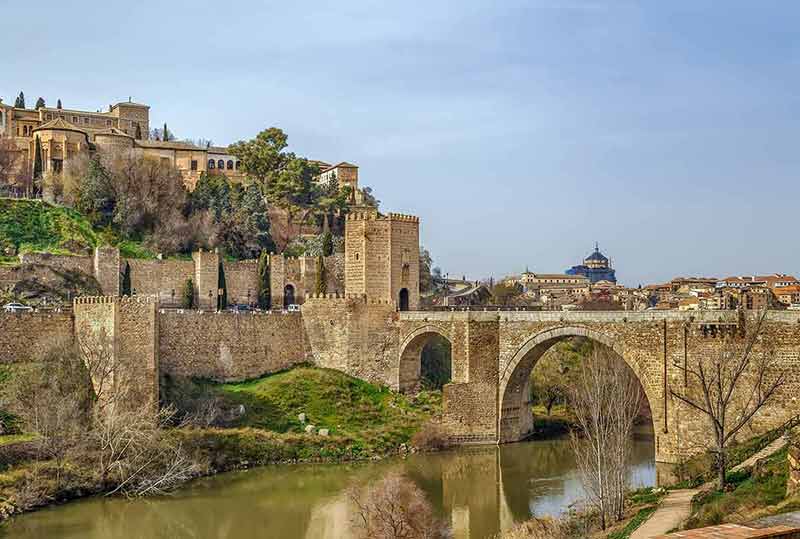
Built between 104 and 106 AD after founding the city, the Puente de Alcántara was one of Toledo’s few entrances for thousands of years.
The name Alcántara comes from the Arabic word meaning “The Arch”.
The design exemplifies Roman construction, with six stone arches spanning 308 ft (194 meters) across the river, giving structural support and beauty to this impressive feat of engineering.
After the Moorish Conquest, the smallest arch to the left was destroyed in 1214 but was later rebuilt in 1543 using stones from the original quarry.
When the Spanish regained control, they destroyed the second arch on the right two times to prevent Portugal from invading.
Then later, during the war for independence in 1809, it was blown up to cut off the French troops from entering Toledo.
81 years later, Queen Isabel II used mortar to make it functional again.
In its centre, a 46 ft (14 meters) high arch known as the Arc-de-Triomphe commemorates the bridge’s history and dedicates it to Emperor Trajar.
The inscription written by the architect in Latin says, ‘It will last as long as the world does’.
Don’t miss your chance to see the highest Roman bridge in the world.
Recommended tour: Toledo: Three Cultures Walking Tour
7- Explore The Castillo Of San Servando
Originally built as a monastery by order of King Alfonso VI, this castle honoured the saints Servando and Germano.
In later years, due to its proximity to the Alcántara Bridge, King Alfonso VIII gave the castle to the Knights Templar, who then transformed it into a fortress for the city’s defence.
Constructed on the ruins of an Arab castle, Castillo of San Servando represents some of of the best Mudéjar military architecture in all of the country.
The imposing square design of the castle with high walls and cylindrical towers is constructed from masonry and brick.
The castle serves as a youth hostel and dormitory, housing local teens and young visitors to Toledo wishing to learn more about the city’s rich history.
Tours are also popular due to the legend of a knight, Don Nuño Alvear, who haunts the castle.
Supposedly, after being shown his many victims in a vision, he died inside the castle and roams the passageways today.
Many have claimed to see or feel his presence on the grounds.
Castillo of San Servando is located at Cta. de San Servando, s/n, 45001 Toledo, Spain.
Recommended tour: Toledo: Templar Order Tour
8- Start Your Day At The Plaza Zocodover
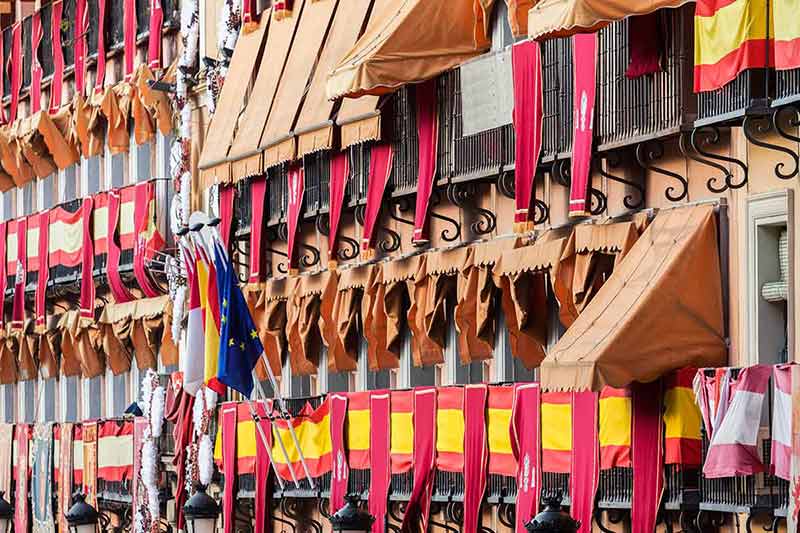
Once an Arab animal market in the heart of Toledo, the lively scene at Plaza Zocodover or the ‘market of the beasts of burden’, attracts both locals and visitors alike.
Long ago, bullfights and duels took place in this square between the Roman wall and the rest of the city.
Start your adventure here with a cup of coffee or a bite to eat before heading down the winding narrow streets of the city.
This large plaza historically serves as the main square in Toledo, and because it’s a great meeting point, this area accommodates visitors to Toledo for various events throughout the year.
Besides the restaurants and cafes, you can visit the tourism centre and get a map and information for your visit to the city.
The cathedral Alcázar and other historical sites are nearby.
As you exit the plaza, walk through the Arco de la Sangre, a gateway to the narrow streets and lush vegetation in the valley, before reaching the river.
Along the way, look out for the statue of Miguel de Cervantes, the author famous for writing Don Quixote or stop at one of the many shops or bars on the narrow streets.
Recommended tour: Toledo: Puy du Fou España and “El Sueño de Toledo” Entry
9- Admire The Incredible Paintings Of A Brilliant Artist At The El Greco Museum
Located in Toledo’s Jewish quarter, this museum houses an immense collection of paintings by El Greco, a Spanish artist from the Golden Age.
Wander through the old 16th-century house and courtyard and the extension built in the early 20th century.
In this museum, inaugurated in 1911, you will find a large collection of El Greco’s paintings, mostly from the painter’s last period, and some works from other 17th-century Spanish painters.
The interior decorations and furniture come from the same era, along with pottery from Talavera de la Reina.
The El Greco Museum is at P.º del Tránsito, s/n, 45002 Toledo.
Recommended tours:
10- Enjoy The Best View Of Toledo At The Mirador del Valle
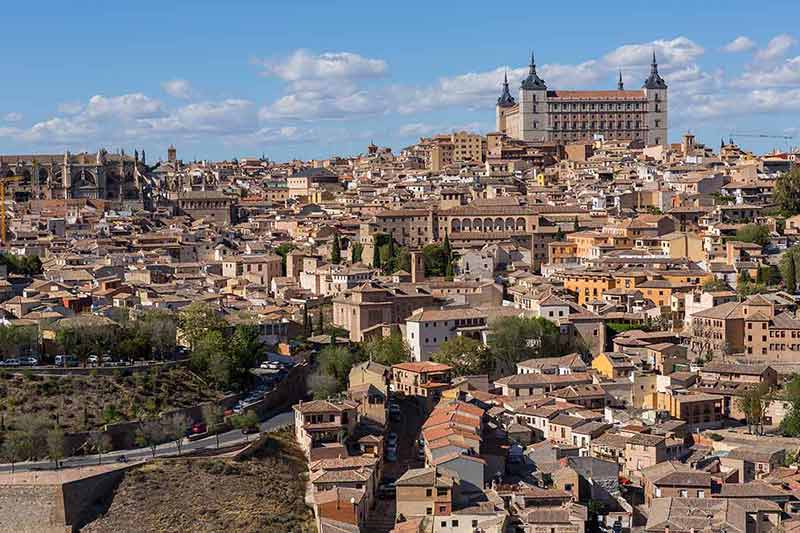
High above the city on the other side of the Tagus River, the Mirador del Valle gives you incredible scenic views of Toledo and the surrounding landscapes.
You can see the cathedral, the Alcazar, San Juan de los Reyes, and other churches that rise above the ancient Toledo wall.
Travelling along the Ronda de Toledo, you will encounter multiple viewpoints as you climb.
If you are driving, several pull-offs along the road allow you to stop and get a better look.
You can also hike a loop starting from Puente de San Martín, climbing up to the Mirador, and returning on the other side of the city, crossing the Puente De Alcántara.
The entire route takes around 50 minutes, with a steady uphill climb at the beginning.
Just past the Mirador on the left, the Kioski Base terrace offers a great place to relax, have a drink, or have something to eat for lunch or dinner.
Sit and watch the beautiful sunset over Toledo before returning to the city.
Mirador del Valle is located at Ctra. Circunvalación, s/n, 45004 Toledo, Spain
11- Get A Glimpse Of El Greco’s First Paintings At Convento de Santo Domingo El Antiguo
If you wish to see some of El Greco’s first paintings when he arrived in Toledo, visit the Convento de Santo Domingo El Antiguo, the city’s oldest monastery and his final resting place.
In addition to the nine commissioned paintings, El Greco designed the altarpieces and sculptures in wood and stone, considering the light and shadows they would project.
You can also examine the original contracts El Greco signed and see his tomb through a small window next to the entrance of the current choir.
The monastery dates back to the 6th century, but during the 11th century, King Alfonso VI ordered its rebuilding.
In 1577, further changes reformed the building into Mannerist Style we see today.
Convento de Santo Domingo El Antiguo is at Pl. Sto Domingo Antiguo, 2, 45002 Toledo.
12- Walk Through The Magnificent Puerta De Bisagra Nueva
As one of the most iconic structures in Toledo, the enormous Puerta De Bisagra Nueva gate brings you into the city’s historic centre from the north.
Experts in architecture believe its origins are from Moorish designs, but we may never know the answer after heavy reconstruction in the 16th century masked its original design.
In between the two massive circular towers above the entrance, the domineering imperial shield of Charles V, with the two seated kings on either side, captures the attention of all that approach.
Puerta de Bisagra Neuva is located at C. Real del Arrabal, 26, 45003 Toledo.
13- Contempate The Construction Of The Puente de San Martín
On the western side of Toledo, the Puente de San Martín, originally constructed in the 13th century from granite, provided additional access to the city, replacing the pontoon bridge destroyed by a flood.
Named after San Martín, the Gothic-style bridge also served as a defensive structure for Toledo, with two large towers protecting the city from attacks.
Five arches support the structure spanning the Tagus River, the largest of which measures 131 ft (40 meters).
Very few bridges in the world then could hold an arch that long.
One very interesting legend surrounds the creation of Puente de San Martín.
The Metropolitan Bishop of the city, Ildefonsus, requested to be present at the inauguration.
While viewing the structure the day before, he realised he had made a dangerous miscalculation in its design and that once the supports were removed, it would collapse into the river.
He returned home to his wife and explained his anguish, and as he slept, she secretly went to the bridge and started a fire to destroy it completely.
This saved the Bishop from disgrace, giving him another opportunity to design the bridge without structural weakness.
14- Gaze At Fantastic Views Of The City At The Puerta Del Sol
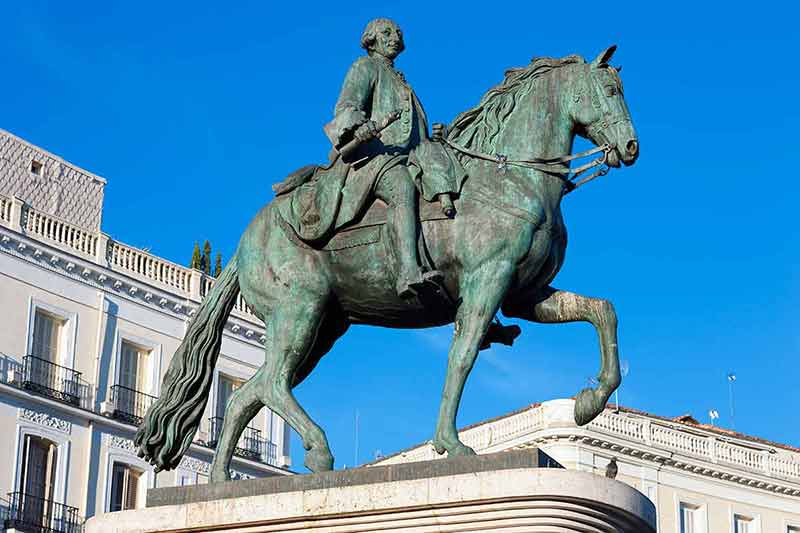
Attached to the Roman wall built in the 1st century AD, on the northeast side of Toledo, the Puerta del Sol functioned as a defensive structure and watchtower protecting the city from outside attacks.
The Knights Hospitallers built this gate to the walled section of the city in the 13th century.
The elegant design features a horseshoe arch flanked by a rectangular tower on the right and a semicircular one on the left.
The beautiful upper section, with blind arches made of brick, displays one of the best examples of Mudéjar architecture.
Below the blind arches, a large emblem representing the cathedral completed in the 18th century depicts the Imposition of the Causuble on Saint Ildefonso under the sun and the moon, hence why the gate is named Puerta Del Sol.
It’s near the Mezquita Cristo de la Luz at Cjón. San José, 2, 45003 Toledo.
15- See El Greco’s Painting At Iglesia de Santo Tomé
In the historical centre of Toledo, the Iglesia de Santo Tomé boasts an impressive tower displaying some of the best Mudéjar art anywhere in this ancient city.
Earliest accounts of the church date back to the 12th century, mentioning it had been constructed upon a mosque from the previous century.
Early in the 14th century, the Lord of Orgaz ordered the church to be rebuilt into the structure we see today.
You will find El Greco’s famous painting, ‘The Burial of Count Orgaz’ in a special room in the back of the church.
This work of art has drawn considerable attention to the Iglesia de Santo Tomé.
Iglesia de Santo Tomé is located at Pl. del Conde, 4, 45002 Toledo, Spain.
16- Visit Toledo’s Art Collection At Museo de Santa Cruz
This 16th-century building houses an extensive art collection inside a former hospital separated into three sections.
Explore Roman, Visigoth, Moorish, and Mudéjar archaeological artefacts on exhibit in one museum area.
Then wander through the fine arts collection displaying beautiful paintings from the 16th and 17th centuries, including some of El Greco’s best works.
The final section delves into industrial arts, exhibiting local crafts such as ceramics, glass pieces, fabrics, and wrought iron metalwork.
Museo de Santa Cruz is located at C. Miguel de Cervantes, 3, 45001 Toledo, Spain.
17- Attend A Performance At Puy du Fou España Theme Park
Opened in 2021, Puy du Fou España offers live entertainment day and night and 74 acres (30 hectares) of four historic villages to explore.
The theme park won numerous awards in its first year of opening and draws thousands of visitors daily for performances.
Learning about Spanish history and fun for the entire family is also exciting.
Puy du Fou España is at CM40 salida, 13, 45004 Toledo. Book your tickets here and skip the line.
18- Learn About Jewish History At Sinagoga De Santa María La Blanca
Located in the Jewish Quarter, this 12th-century Mudéjar synagogue, converted to a Christian Church after the reconquest of Toledo in 1405, has incredible Moorish architecture.
28 horseshoe arches are supported by octagonal columns covered in pine-cone sculptures at the capitals.
At one point, in the church’s eastern wall facing Jerusalem, a large chest once contained the scrolls of the Torah.
The coffered ceilings are made from larch in a design typical of Mudéjar construction.
The synagogue, considered by many to be the oldest in Europe and the best example of Almohad-era art, fascinates visitors with its history, intricate craftsmanship, and unique origins.
Sinagoga De Santa María La Blanca is located at C. de los Reyes Católicos, 4, 45002 Toledo.
Recommended tour: Toledo: Sepharad Jewish Quarter Walking Tour
19- Explore Italian Art and El Greco’s Works At Hospital De Tavera
Also known as the San Juan Bautista Hospital, built in the Spanish Renaissance style, it houses one of the best museums in Toledo, featuring famous Italian art from the 16th to 18th centuries and works from El Greco, Berruguette, Rivera, Tintoretto and Titian.
Construction began in 1541 under the watchful eye of Cardinal Juan Pedro Tavera, who intended to create a structure for two purposes.
One section would be for ‘the headdresses of different diseases” and the other, a pantheon of its founder.
Here you can see his marble tomb during your visit.
Save time to explore the preserved 16th-century pharmacy, one unique part of the Hospital De Taverna, where you will glimpse the drugs and medicine used at that time.
The pharmacy also contains a precious collection of 16th-century ceramic jars.
Hospital De Tavera is at C. Duque de Lerma, 2, 45003 Toledo, Spain. Skip the line and book your entry tickets here.
20- Go Back 700 Years In History At Convento De Santa Clara La Real
Preserved for seven centuries and recently restored, the convent now opens its doors for the first time to the public.
See the Mudéjar art collected by the Poor Clare Sisters since the 15th century, and see how the nuns lived and worshipped for hundreds of years.
Founded by Francis and Clare of Assisi, the beautiful naves in the convent are adorned with spectacular gold decorations featuring artworks from centuries ago.
The ornate wooden sculptures have been perfectly restored into brilliant condition.
The convent, comprised of four sacred rooms, excites visitors at every turn.
Convento de Santa Clara la Real is located at Pl. Sta. Clara, 5, 45002 Toledo.
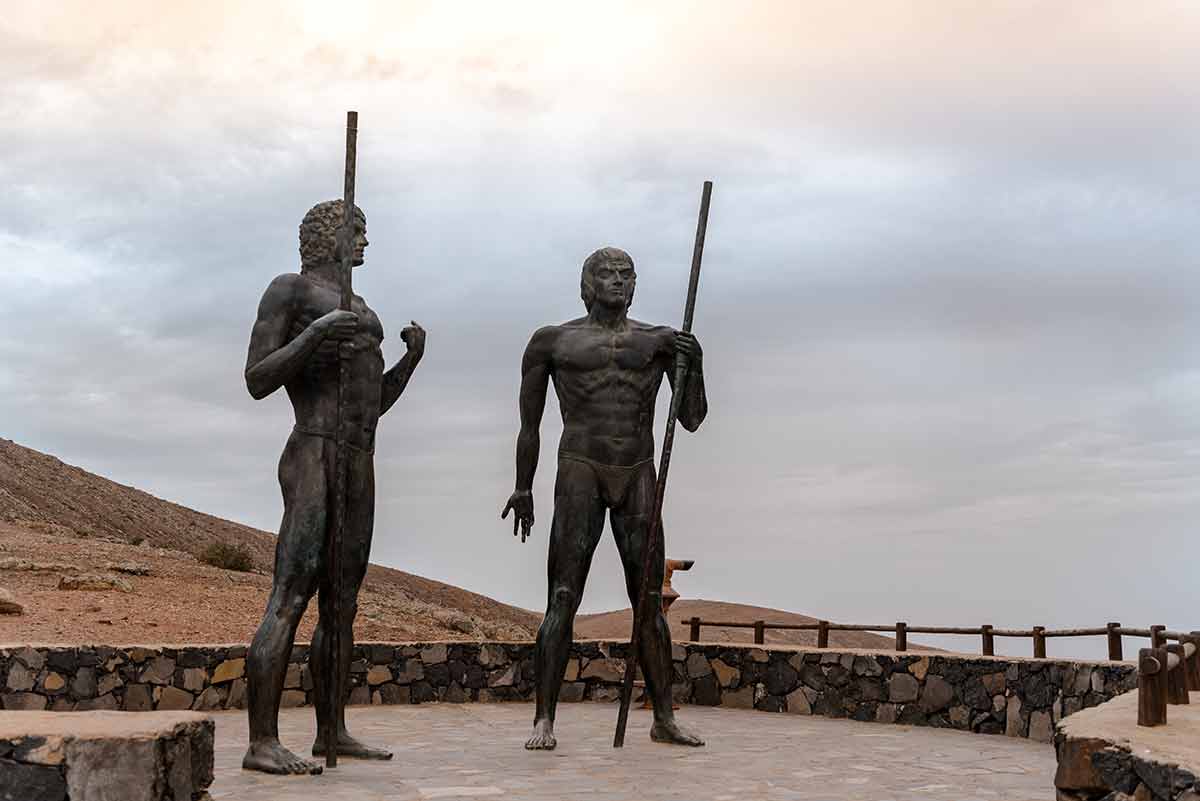
Love Spain? Read these posts:
- 27 Spanish Shows On Netflix
- 20 Fairytale Castles In Spain
- 30 Landmarks in Spain
- 20 Places To Visit In Spain In Winter
- 20 Best Beaches In Spain
- An Amazing Andalusia Road Trip
- 20 Things To Do In Ibiza
- 20 Things To Do In Tenerife
- 21 Things To Do In Lanzarote
- 21 Spanish Drinks To Try
- 20 Things To Do In Madrid At Night
- 20 Day Trips From Madrid
- Best Time To Visit Spain
- 20 Cities in Spain
- Renting A Car In Barcelona
- 20 Things To Do In Seville
- 20 Things To Do In Granada
- 20 Things To Do In Zaragoza
- 20 Things To Do In Palma
- 20 Tours In Spain
- 20 Things To Do In Alicante
- 20 Spanish Food / Dishes
- 20 Things To Do In Ronda
- 20 Things To Do In Cadiz
- 20 Thing To Do In Benalmadena
- 20 Things To Do In Torremolinos
- 20 Landmarks In Barcelona
- 5 Day Trips From Barcelona
- Barcelona Bike Tour
- 10 Things To Do In Bilbao
- 12 Things To Do In San Sebastian
- 10 Things To Do In Oviedo
- Storybook Village of Santillana del Mar
- 20 Things To Do In Gran Canaria
- 20 Things To Do In Barcelona At Night
- Christmas in Spain
- 20 Things To Do In Malaga
- 20 Things To Do In Marbella
- 20 Things To Do In Valencia
- Where To Stay In Valencia
- Ibiza At Night
- 20 Things To Do In Ibiza
- 20 Things To Do In Toledo
- Where To Stay in Barcelona
- 20 Things To Do In Segovia
- Where To Stay in Tenerife
- Where To Stay in Madrid
- Where To Stay In Mallorca
- Where To Stay In Ibiza
- 15 Things Spain Is Famous For
Plan Your Trip

Rent A Car – Find the best car rental rates at Discover Cars. They compare car hire companies to provide you with the best deal right now.

Find A Hotel – If you’re curious about this article and are looking for somewhere to stay, take a look at these amazing hotels.

